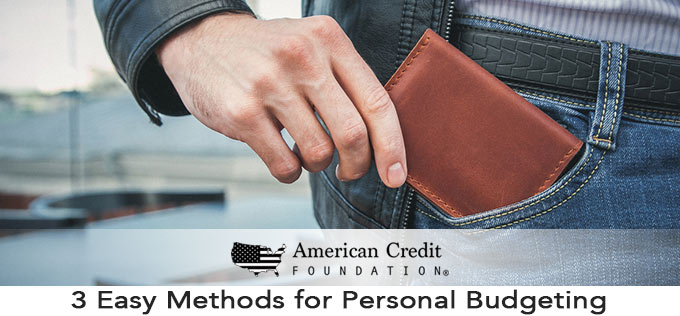3 Easy Methods for Personal Budgeting

You have a personal budget, right?
If you answered “No,” you’re not alone… for better or worse: A 2020 survey by the National Foundation for Credit Counseling revealed that less than half of Americans (47%) use budgeting methods to track their personal spending.
But if you’re serious about maintaining – or regaining – some solid financial footing, this might not be the company you want to keep.
After all, a budget is the most fundamental weapon in your financial planning arsenal. It provides a clear picture of your cash flow, helps you plan your spending with your own best interests in mind, and enables you to reach your financial goals.
Finding the budgeting method that works for you is crucial to making this a long-term habit. Let’s discuss the tried-and-true 3 easy methods for personal budgeting to get you started.
The Pay-Yourself-First System
It’s YOUR money, after all, so make it work for you. Pay-yourself-first budgeting is like a reverse budget that focuses on savings and debt repayment. You first determine how much to pay yourself to put toward your savings and debt goals each month. For instance, you can build up your emergency fund or pay off high credit card debt. Then you allow yourself to spend whatever is leftover.
How it works: You set aside a specific amount from every paycheck for savings and debt payments. Then prioritize your necessary bills and monthly expenses. And then you’re free to use the rest of your money however you see fit. Because you’ve already earmarked funds for what’s most important to you (in this case, your emergency account, and your credit card debt) and paid your mandatory expenses, you don’t have to worry about spending your discretionary income.
Who it’s best for: This system is best for someone who struggles with saving each month or doesn’t want to focus too much on budgeting each expense.
The Envelope System
This strategy focuses on paying down debt quickly and using cash, not credit cards. You plan your spending by allocating every dollar of your monthly income to your selected budget categories. The “goal” is to have zero dollars remaining (or unaccounted for) at the end of the month, meaning that you’ve found a purpose for every last dollar. This doesn’t mean you are spending frivolously – the bulk of your income (and anything unaccounted for) can be allocated for savings or debt payoff.

How it works: Determine your spending categories and spending limits for each category. Withdraw only the cash you need to fill each envelope based on your spending limits. Label a physical envelope for each spending category. At the beginning of each month, place the monthly cash available for that category into the envelope. When the envelope is empty, you can’t spend any more on that category until next month when you refill the envelope. Be vigilant, and avoid raiding other envelopes if you zero out one category.
Who it’s best for: It’s a good budgeting method for someone who feels comfortable having a lot of cash on hand and has no strong preference for using plastic.
The 50/30/20 System
A 50/30/20 budget breaks down your expenses into three categories and assigns specific percentages of the total for each:
- Needs – Monthly requirements like housing, insurance, transportation (50%)
- Wants – Discretionary expenses like eating out, shopping, travel (30%)
- Funds – Savings and debt payments (20%)
How it works: You allocate only the percentages you’ve set for each category. But there’s no meticulous tracking of all your expenses. And there’s no need to stick with the 50/30/20 proportions. Feel free to customize the system to your needs. If you don’t have many “wants” one month, maybe you want to increase your debt payment. If your “needs” increase, perhaps you may want to consider decreasing your discretionary expenses.
Who it’s best for: People who aren’t looking to pay off significant debt will find this an easy, workable system.
If you’re new to budgeting, remember that it’s a journey. You don’t need to worry about perfection – it’s more important that you establish a routine that keeps track of where your money is going and gives you more control over the process. You might struggle initially, but we promise that the initial hardship is worth it! Over time, it will become almost second nature, and your financial stability will improve. Already tried these 3 easy methods for personal budgeting unsuccessfully? Contact American Credit Foundation today to speak with a friendly team member who can advise you on alternative techniques.

